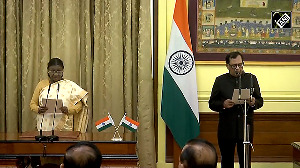The Prime Minister's Economic Advisory Committee member Govinda Rao said on Tuesday India might clock less growth than the last fiscal and called for a 200 basis point cut in the cash reserve ratio by the Reserve Bank.
"It is not very much likely to be the last year's growth rate . . . it could be less, it could be marginally less ... it will be between 6.5 to 7 per cent," Rao told PTI on the sidelines of a Budget discussion by the public sector units.
India grew at 6.7 per cent in 2008-09. For the current fiscal 2009-10, the Economic Survey projected a 7 per cent growth rate plus/minus 0.75 per cent.
"The external environment has not yet improved, you had a negative growth rate of industrial production in April . . . you need to come out of it . . . power sector has not been doing extremely well, infrastructure sector has come out but then more time is needed . . . you need to be a little more realistic," he said.
Rao, also the director of the National Institute for Public Finance and Policy, questioned the need for having the CRR, the funds banks are required to park with the RBI, at 5 per cent when they keep 24 per cent of their demand and time liabilities in government securities as statutory liquidity ratio.
". . .when you are saying that 24 per cent of the money government is borrowing through the SLR, do you really need further safety mechanism. It's a sovereign guarantee," Rao said, suggesting for a reduction in the key reserve ratio.
"You can reduce another 2 per cent . . . to something like 3 per cent at this stage. It won't hurt . . . it will increase the liquidity. It releases that much of money for the banking system to lend," he added.
Worried over the 6.8 per cent fiscal deficit target for the current fiscal, he said the deficit coupled with the states' borrowings of 3.5 per cent of the GDP would leave little for the corporates to borrow and at high interest rates.
"Financial sector savings of the households is 11 per cent of GDP, out of which 10.3 per cent (6.8 plus 3.5) goes to the government. So, only 0.7 per cent is available to the corporates. That drives up the interest rates and with the higher interest rate they cannot borrow," he said hinting at financial crowding out of private investment.





